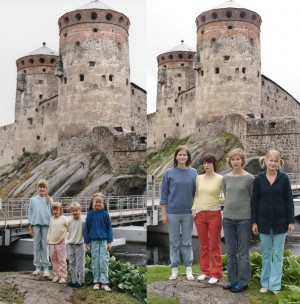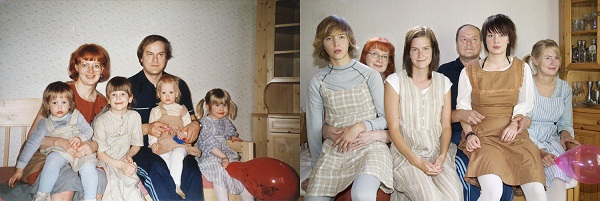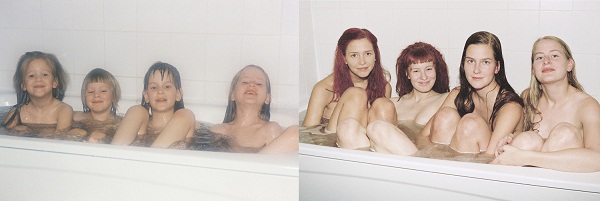Artist of the Week 9/12-9/18: Wilma Hurskainen Recreates Her Childhood Photos
GALO: You revealed to the My Modern Met blog that a lot of the accessories, props, and costumes that were used in the original photos, were hidden away in your parent’s house and were reused for the purpose of the series. You further expressed that finding these materials was “strange.” Why did it give off a feeling of oddity to find these things stashed away and what sort of memories did it bring back for you and your sisters? Did any of you end up keeping some of the items or did they once again become something of the past, hidden away?
WH: We were able to find a lot of the old clothes and toys — my parents´ house is such a huge treasure box. I think they´ve started getting rid of things lately, but by the time we were photographing the series, they still seemed to have a lot of our childhood stuff stashed in the closets. It was hilarious, but also a little strange, finding these old clothes — like taking a trip in the time machine. In the photographs, it sometimes looks as if the clothes and furniture had shrunk, instead of us growing up. In the beginning, I wasn´t so concerned with the details like clothes, but gradually, I grew more aware of the little things.
GALO: Though your series is currently receiving a surplus of attention in the U.S. from the media, such as the Huffington Post, to diverse blogs and social outlets, Growth had already lived through such fame in 2008, when a book on the series was published in Finland. Furthermore, the book spurred an interest in the series and it was shown across various galleries both in Finland and abroad. Are you at all surprised that six years after the project’s completion and the publishing of the book, the series is only now reaching the other side of the ocean in such a grandeur manner? Has this at all made you consider republishing the volume or perhaps bringing the series to the U.S. in the form of a traveling exhibition?
WH: The attention that the work has had lately has been just overwhelming; I´m happy, of course, and a little confused. The volume of people who see and share things on the Internet is just so different from the amount of people who see art in exhibitions. I was already so happy with how well the series was received in 2004-2008 — and now this! But I think these phenomena spread really fast and then also pass quite quickly.
But I have received such nice comments and e-mails, and people have come to talk to me at exhibitions, etc. It´s so great when people share their own childhood memories, tell about their fathers and their sisters, or tell me that they have or will do something like this themselves. I feel fortunate to get these comments.
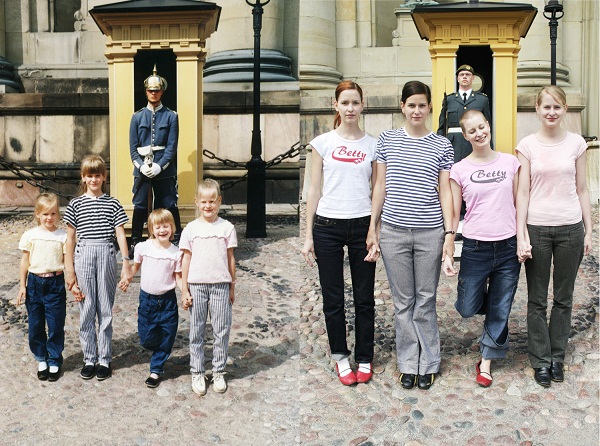
“The Royal Palace” from the “Growth” series by Wilma Hurskainen. Photo Credit: Wilma Hurskainen.
GALO: When your parents saw what you were doing, particularly your father who himself had taken the original photographs, what was their reaction? Was he involved in the new series at all – perhaps he was the one who retook the new pictures?
WH: My father must have been quite confused when we started doing the series. He´s a very matter-of-fact guy and it hasn´t always been so easy for him to deal with five women in the house! But even as we started, he seemed to be very proud because his work was being repeated. He is present in at least two [of the] images, too. He sometimes assisted us with the shootings: we had the camera on a tripod and either we used self-release or asked someone to push the button. But then sometimes, he started interfering and ordering me to do things a certain way, and I would be like: “No! Now it´s me who gets to decide!”
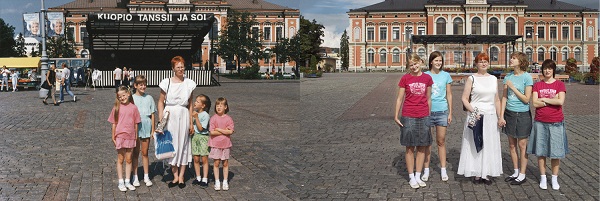
(Top image) “Kuopio Market Square” and (below)”Family Portrait” from the series “Growth” by Wilma Hurskainen. Photo Credit: Wilma Hurskainen.
GALO: According to the My Modern Met blog, you had trouble with one of the photos that involved the location of the Skansen Zoo in Stockholm and a few elephants, which unfortunately were no longer alive due to a case of tuberculosis, as the area had changed tremendously since the first time the picture was taken. What were some other difficulties you encountered while working on this project and which image, besides the aforementioned one, proved to be the most problematic to recreate?
WH: We had technical problems (like finding the right framing because we wouldn´t fit where we had been earlier and the whole composition had to be changed, or the weather was wrong and we knew we couldn´t go back to the location later) but most of the stress was caused by dealing with my sisters and parents, trying to keep positive and convince them it was worth doing. The years when we were shooting the series were not the easiest in our family — but again, that might be why I wanted to make the series in the first place.
GALO: In the midst of the difficulties, there must have been quite a few comical and happy moments. For instance, your height must have caused a few giggles amongst all of you when you compared the various images, and laughter had to surely ensue when all of you had dressed up in the traditional costumes you wore on Easter or as gnomes? Not to mention, the photo of all of you in the bathtub together! Care to share one or two stories behind one or two photos that brought about laughter amongst the group?
WH: But then again, although we had some horrible moments, fighting in our little-girl outfits in foreign cities and swearing never to see each other again, we did have fun too! Just looking at the old photographs, going through them over and over, was fun and somewhat therapeutic. We would make sisterly fun of each other because of the roles we had had as children — those roles really seem to stick, by the way. And trying to fit into the bathtub: “Take your elbow out of my face… No, you put those legs of yours somewhere else…” We had like five centimeters of water in the tub and it would spill over once we were in there.
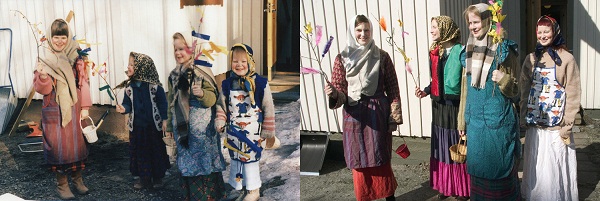
(Top image) “Easter” and (below) “In the Bathtub” are photos from the series “Growth” by Wilma Hurskainen. Photo Credit: Wilma Hurskainen.
GALO: Do you plan to redo this type of series again in another 20 to 30 years as a means of revisiting the past and creating an amusing and creative history timeline for future generations? Or perhaps, this is something you wish to continue with your other family members?
WH: I would love to do it again in like 10 to 15 years. But it´s hard to predict what will happen in the future, you just never know. After we finished the series, I suggested to my sisters that we should repeat the process in another 15 to 20 years and got a nice strict “NO!” But maybe when time passes…
GALO: Would you encourage others to try this method of commemorating the past while at the same time letting go and enjoying the present and future?
WH: I encourage people to do the same — it´s just so fascinating even if the details don´t match perfectly! It is an incredible thing about photography — it allows us to compare different moments in time through such a simple practice.
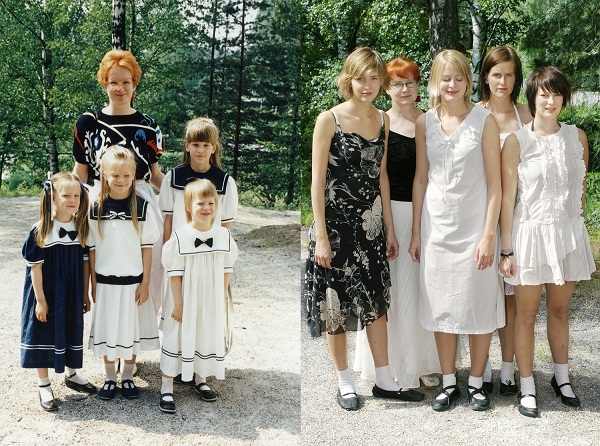
“On the Yard” is a photo from the series “Growth” by Wilma Hurskainen. Photo Credit: Wilma Hurskainen.


